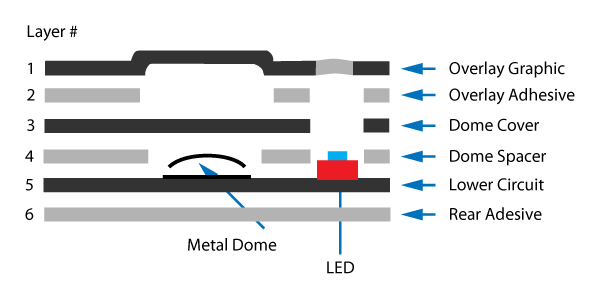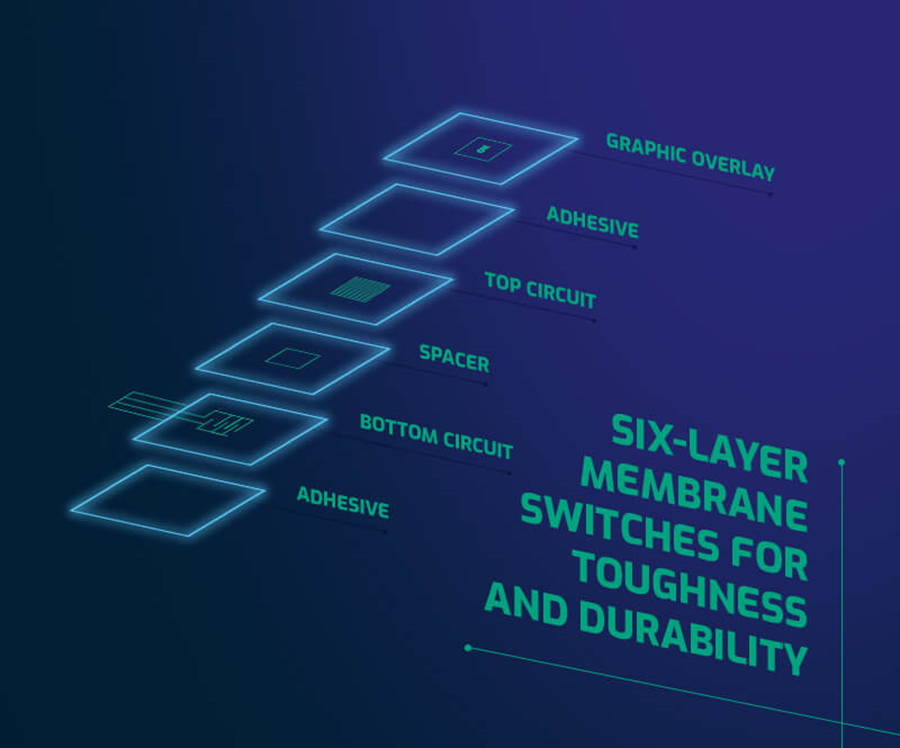Exploring membrane switch applications in high-risk environments
Wiki Article
Recognizing the Importance of Membrane Switch Over in Modern Electronic Devices
Membrane layer switches are integral components in modern-day digital gadgets. They use a blend of performance and design that boosts customer interaction. Their lightweight and long lasting nature makes them ideal for different applications. As markets progress, the need for personalization and advanced functions grows. Understanding just how membrane switches add to development discloses their relevance in shaping the future of electronic devices. What lies in advance for this innovation?The Basics of Membrane Layer Switch Modern Technology
Although commonly neglected, membrane layer switch modern technology plays a crucial function in the modern-day electronics landscape - membrane switch. These gadgets, composed of several layers, function as individual interfaces for numerous electronic items, varying from home devices to medical tools. A typical membrane button includes a graphic overlay, a spacer layer, and a circuit layer, which are thoroughly constructed to create a functional interface.When stress is put on the overlay, the circuit layer is finished, allowing signals to be transferred to the tool. This technology is understood for its convenience, enabling customization in capability, form, and style to fulfill details customer demands. Additionally, membrane switches are thin and lightweight, making them suitable for applications where space is a costs. Their sturdiness and resistance to environmental factors further enhance their charm, ensuring they can withstand severe conditions while maintaining functionality. Overall, membrane button modern technology is indispensable to developing easy to use and effective electronic devices
Secret Advantages of Membrane Layer Changes
Membrane switches over offer several vital advantages that make them a favored option in numerous digital applications. Their layout permits a compact kind aspect, allowing suppliers to produce lightweight and streamlined devices. In addition, membrane buttons are resistant to dirt, moisture, and chemicals, which boosts their longevity and durability popular atmospheres. The responsive comments given by these switches can boost user experience, making them very easy and intuitive to operate.Furthermore, membrane layer buttons can be customized with varied graphics and shades, enabling one-of-a-kind branding opportunities. The production process is normally cost-effective, particularly for high-volume manufacturing, as it reduces assembly time and streamlines layout. Membrane layer switches over require very little upkeep, adding to lower total functional prices. These benefits underscore their growing popularity in contemporary electronic devices, where integrity and user-friendly interfaces are crucial.
Applications Across Numerous Industries
The adaptability of membrane layer changes allows their extensive fostering across numerous markets. In the clinical field, they are commonly utilized in analysis devices and patient surveillance systems, providing a durable user interface immune to pollutants. The automotive market makes use of membrane buttons for control panel controls, improving customer experience with sleek styles that withstand extreme conditions. In customer electronic devices, they act as control board for devices such as microwaves and coffee manufacturers, giving a straightforward interface that is simple to tidy. The aerospace industry utilizes membrane layer switches in cabin controls, where dependability and room efficiency are critical. In addition, the industrial sector leverages these buttons in equipment and control systems to assure robust operation popular settings. This wide series of applications highlights the versatility of membrane layer buttons, making them integral components in improving capability and customer communication across diverse technological landscapes.Personalization and Style Adaptability

Future Fads in Membrane Layer Switch Over Development
Arising fads in membrane layer button growth show an expanding focus on boosted performance and integration with smart technologies. As customer demand for extra advanced digital tools increases, suppliers are concentrating on producing membrane layer changes that not just serve fundamental functional duties but additionally include functions like touch sensitivity, backlighting, and haptic feedback.Furthermore, developments in materials are anticipated to enhance sturdiness and environmental resistance, making membrane layer changes suitable for varied applications in markets such as healthcare, auto, and consumer electronics. The combination of capacitive touch technology is most likely to end up being more common, enabling sleeker designs and boosted individual interfaces. membrane switch.Additionally, the rise of the Web of Things (IoT) is triggering the development of membrane layer switches that can interact wirelessly with various other gadgets, boosting interconnectivity. Generally, the future of membrane switch modern technology appears promising, driven by technology and the quest of straightforward optionsFrequently Asked Inquiries
Exactly How Do Membrane Changes Contrast to Conventional Mechanical Buttons?
Membrane layer switches, being a lot more space-efficient and offering a smooth layout, contrast with standard mechanical switches that give responsive feedback. The previous often include personalized graphics, while the latter usually assure sturdiness and integrity in various applications.What Products Are Commonly Used in Membrane Switch Manufacturing?
Membrane layer buttons are typically created using products such as polyester, polycarbonate, and printed conductive inks. These materials provide responsiveness, toughness, and flexibility, making them ideal for numerous applications in digital devices and interface.Can Membrane Switches Be Repaired or Recycled?
Membrane switches can frequently be repaired, particularly if small problems occur, such as sticky failure or surface area damages. Nevertheless, complete reuse is commonly restricted because of wear and potential deterioration of materials with time.
How Do Ecological Elements Affect Membrane Layer Switch Efficiency?
Environmental variables, such as read the full info here humidity, temperature, and direct exposure to chemicals, significantly affect membrane button efficiency. Severe conditions can bring about deterioration, influencing responsiveness and longevity, eventually endangering the functionality of the tool in various applications.What Is the Normal Life-span of a Membrane Change?
The typical life expectancy of a membrane layer switch typically varies from 1 to 5 million actuations, relying on factors such as use regularity, environmental conditions, and the materials utilized in production, impacting resilience and efficiency long life. A common membrane layer switch is composed of a visuals overlay, a spacer layer, and a circuit layer, which are carefully constructed to produce a useful interface - membrane switch.When pressure is applied to the overlay, the circuit layer is finished, allowing signals to be sent to the gadget. The tactile responses offered by these switches can boost user experience, making them very easy and intuitive to operate.Furthermore, membrane buttons can be tailored with diverse graphics and colors, allowing for unique branding possibilities. As customer need for more sophisticated digital tools rises, suppliers are concentrating on developing membrane layer changes that not only serve fundamental operational functions but also incorporate features like touch sensitivity, backlighting, and haptic feedback.Furthermore, improvements in products are anticipated to enhance longevity and ecological resistance, making membrane layer switches over ideal for varied applications in markets such as healthcare, automotive, and customer electronic devices. The assimilation of capacitive touch modern technology is most likely to end up being a lot more widespread, enabling for sleeker designs and boosted customer interfaces.Additionally, the increase of the Internet of Points (IoT) is triggering the development of membrane layer switches over that can interact wirelessly with other devices, boosting interconnectivity. Membrane switches, being extra space-efficient and using a streamlined style, contrast with typical mechanical buttons that provide responsive feedbackReport this wiki page